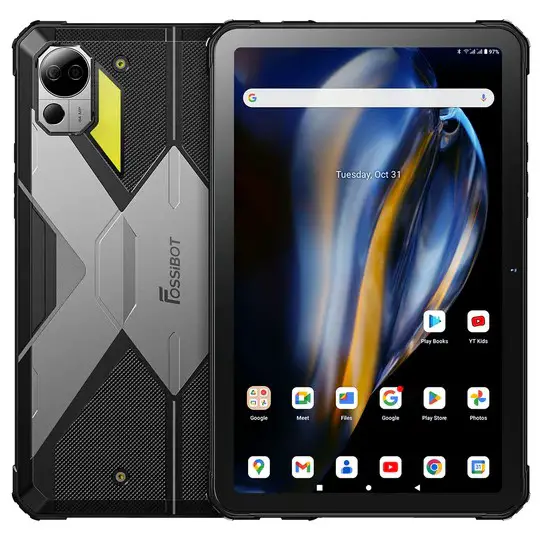

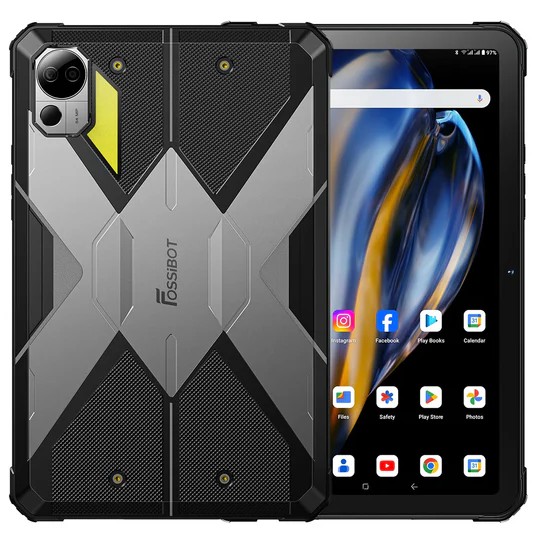
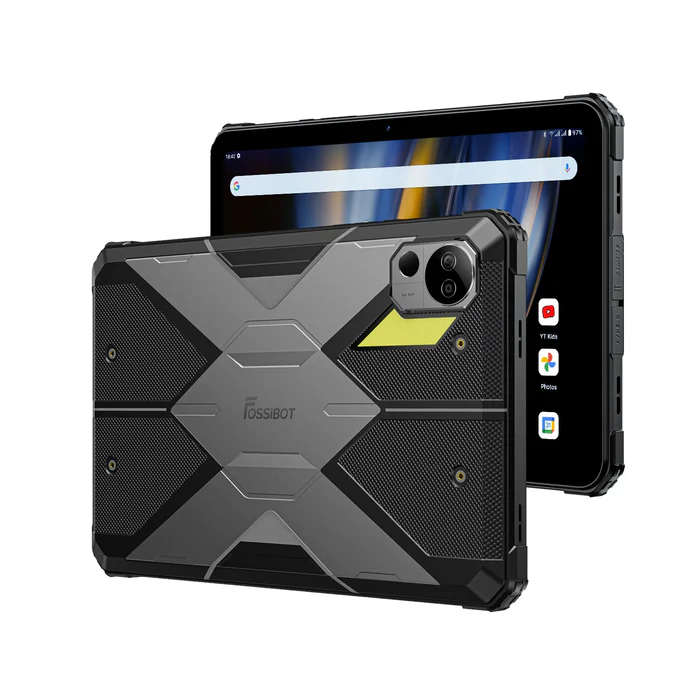
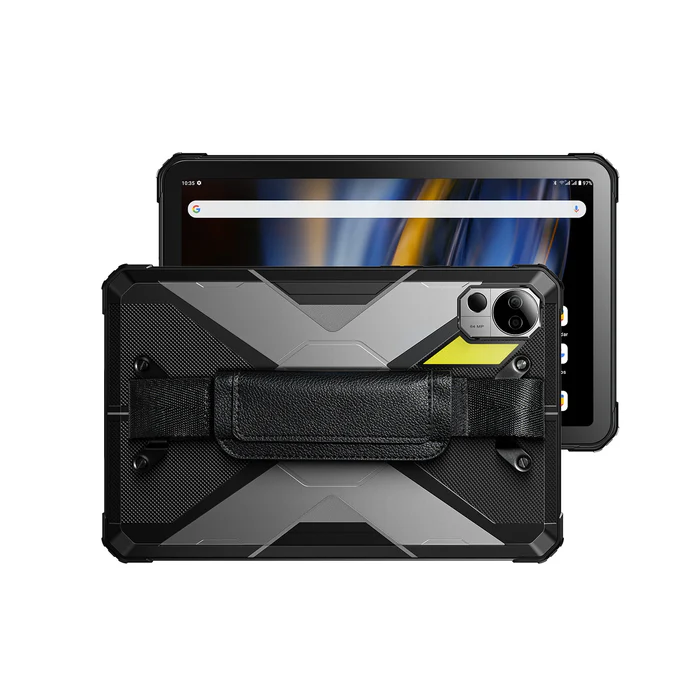
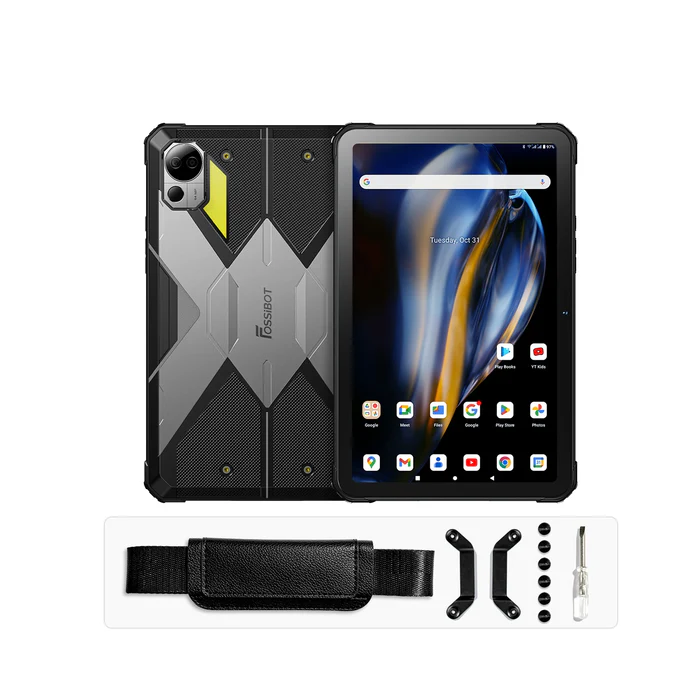
The Fossibot DT2 is the successor to the DT1 series of rugged Android tablets. It takes the DT1's core strengths of durability and functionality and injects them with a significant performance boost and a massive battery upgrade. This combination makes the DT2 a compelling option for users who require a powerful and dependable tablet for demanding tasks, especially in environments where power outlets might be scarce.
The DT2 boasts a rugged build with IP68 and IP69K ratings, signifying its resistance to water and dust ingress. It also meets the MIL-STD-810H certification for shock resistance, ensuring it can handle bumps and drops. It's important to note that the DT2 is slightly thicker and heavier compared to the DT1 tablets.
Under the hood, the DT2 packs a significant upgrade. It ditches the MT8788 chipset found in the DT1 series in favor of a more powerful MediaTek Helio G99 built on a 6nm process. This potentially translates to smoother performance and improved efficiency, allowing you to tackle demanding tasks with ease. Storage capacity also receives a major bump. The DT2 starts with a generous 12GB of RAM and 256GB of ROM, offering ample space for apps, games, and media. This is a significant improvement over the DT1 series.
The camera system also sees an overhaul. The rear main camera on the DT2 features a 64MP sensor, a considerable jump from the DT1's 48MP. Similarly, the front-facing camera gets a megapixel boost, offering 32MP for capturing selfies and video calls instead of a 16-megapixel lens on it predecessor.
Connectivity options on the DT2 are impressive. It supports various GSM, 3G, and LTE bands, ensuring you can stay connected in most areas. However, it's important to check network support with your carrier of choice before buying.
The DT2 offers Wi-Fi connectivity with support for both standard bands and the next-gen Wi-Fi 6, potentially delivering faster connection speeds compared to the D1 series. Bluetooth 5.0 and a USB Type-C 2.0 port with OTG functionality round out the connectivity options.
Where the DT2 truly shines is in its battery life. It boasts a massive 22,000mAh battery capacity, a significant improvement over the D1's 11,000. This translates to potentially longer usage times between charges, perfect for extended use in the field. Additionally, the DT2 supports faster 66W fast charging, allowing you to quickly top up the battery when needed.
The DT2 comes in Blue and Gray color options and features quad box speakers for an immersive audio experience. The table below contains the full specifications of the Fossibot DT2 rugged Android tablet.
| Launch This refers to the date when this device was officially introduced into the market. | Announced 2023, December 10 / Released 2024, January |
| Brand / Model These are key identifiers that indicate the manufacturer or company that produces this smartphone, and the specific model of the phone. | Fossibot / DT2 |
| 2G Bands 2G refers to the second generation of cellular technology and includes various frequency bands for basic voice and text communication. | GSM Band 850 / 900 / 1800 / 1900 - SIM 1 and SIM 2 |
| 3G Bands 3G refers to the third generation of cellular technology, encompassing different frequency ranges for faster data speeds, mobile internet, and multimedia capabilities. | 3G Bands 1 / 2 / 4 / 5 / 8 |
| 4G Bands 4G refers to the fourth generation of cellular technology, operating in specific frequency bands to provide significantly faster data speeds, supporting high-definition video streaming and advanced applications. | LTE Bands 1 / 2 / 3 / 4 / 5 / 7 / 8 / 12 / 17 / 18 / 19 / 20 / 25 / 26 / 28A / 28B / 38 / 39 / 40 / 41 / 66 |
| Ruggedity This indicates the device's durability and ability to withstand harsh conditions or impacts. It is a very popular term used with tough or rugged phones. IP68/IP69K are international ratings that measure a smartphone's resistance to dust and water. MIL-STD-810H is a military standard that sets criteria for the environmental and durability testing of electronic devices. It means this device has undergone various tests to demonstrate its resilience in challenging conditions, such as extreme temperatures, humidity, vibration, and shock. |
IP68 / IP69K / MIL-STD-810H - Water / dust resistant / shock resistance |
| Dimensions / Weight: This refers to the physical size and weight of the device, measured in millimeter (mm) and grams (g) respectively. | 253.4 x 163.25 x 20.5 mm / 1,065 grams |
| SIM SIM stands for "Subscriber Identity Module." It is a small card, typically inserted into a slot in a mobile phone, that contains important information for connecting the device to a mobile network. SIM cards can come in various sizes, including standard SIM, micro SIM, nano SIM, or even electronic (eSIM), depending on the phone's design. | Hybrid Dual SIM (Nano-SIM, dual stand-by) |
| Screen Display refers to the screen or visual interface of the device. It includes details such as screen size, resolution, and technology (e.g., LCD, OLED, AMOLED). | 10.4-inches / IPS LCD touchscreen / 16M colors |
| Resolution Screen Resolution refers to the number of pixels that make up the display screen and is typically expressed as a combination of horizontal and vertical pixel counts (e.g., 1920 x 1080, 2560 x 1440, or 3840 x 2160). The screen resolution determines the level of detail and sharpness of the visual content displayed on the smartphone's screen. Higher resolutions generally result in crisper and more detailed images and text | 2000 x 1200 pixels / 3:5 aspect ratio / 225 PPI |
| Features Camera features encompass various functionalities and capabilities that enhance the device's photography and videography experience. These features can include Optical Image Stabilization (OIS) Panorama, HDR, Ai Mode, Night Mode, Portrait Mode, etc. | Scratch resistant glass (unknown) |
| OS This is the Operating System. It refers to the software platform that runs on the smartphone and manages the device's hardware and software resources. Common smartphone operating systems include Android (developed by Google), iOS (developed by Apple). | Google Android 13 |
| Chipset This refers to the integrated circuit that serves as the device's central processing unit (CPU). It plays a pivotal role in the smartphone's performance, speed, and energy efficiency. |
MediaTek Helio G99 (6 nm) - Octa-core (2x2.2 GHz Cortex-A76 & 6x2.0 GHz Cortex-A55) - Mali-G57 MC2 GPU |
| Memory This encompasses two components: storage capacity and RAM (Random Access Memory). Storage capacity, typically measured in gigabytes (GB) or terabytes (TB), dictates how much internal space is available for apps, files, and media storage. RAM, measured in gigabytes (GB), is temporary memory crucial for multitasking and app performance, with more RAM generally leading to smoother operation and faster task-switching capabilities. |
12GB RAM + 256GB ROM (LPDDT4x / UFS 3.0) - Expandable RAM: 8GB - SD-card support up to 512GB (uses SIM 2 slot) |
| Main The main camera, also known as the rear camera, is the primary camera on the back of the smartphone. It is typically used for capturing photos and videos in various scenarios and is often the more powerful and versatile camera on the device |
Main: 64MP, PDAF, F/1.8 Depth: 0.3MP |
| Selfie The selfie camera, also known as the front-facing camera, is the camera on the front of the smartphone, primarily used for capturing selfies and video calls | 32MP selfie, F/2.0 aperture, No LED flash |
| Features Camera features encompass various functionalities and capabilities that enhance the device's photography and videography experience. These features can include Optical Image Stabilization (OIS) Panorama, HDR, Ai Mode, Night Mode, Portrait Mode, etc. | 1080p@30fps video recording / LED Flash |
| Connectivity This encompasses the device's ability to connect and communicate with other devices and networks. It includes features such as cellular connectivity, Wi-Fi, Bluetooth, NFC (Near Field Communication), and USB connectivity options. | Bluetooth 5.0 A2DP / WiFi 2.4G-5G, Wi-Fi 6 / FM Radio / USB Type-C 2.0 (OTG) |
| Navigation Navigation refers to the device's ability to determine and display location information and provide directions to users. This functionality is usually powered by Global Positioning System (GPS) technology. | A-GPS, GLONASS, BeiDou, Galileo |
| Sensors This refers to the various built-in sensors that enable the device to gather information from its environment and interactions. Common sensors found in rugged smartphones may include fingerprint sensor, light sensor, barometer sensor among others. | G-Sensor, Geomagnetism, Compass sensor, Gyroscope, Ambient Light Sensor |
| Battery This section refers to the device's power source and its related specifications. This typically includes details such as the battery capacity, measured in milliampere-hours (mAh) or watt-hours (Wh), and it charging details. | Li-Po 22,000mAh, non-removable with 66W fast charger |
| Others This is a catch-all category that includes various additional features, specifications, or capabilities that don't fall under the major categories like display, camera, memory, or connectivity. |
Blue, Gray colors Quad box speakers 1W LED lamp |
These specifications were entered manually, hence we CANNOT guarantee 100% accuracy. Also, that your device is listed on this website DOES NOT call for reckless usage! It is crucial to exercise due diligence, as we cannot be held responsible for any damage to your device due to overconfidence in it built quality.
Leave a Reply